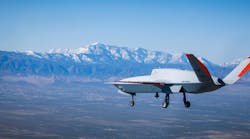Aug. 20--HAMPTON -- It happens every day on I-64: A motorist sees a merging vehicle and decides to slow down, speed up or change lanes -- whatever makes sense.
Now imagine the car is driverless and this is taking place 5,000 feet in the air.
That's the scenario confronting researchers looking to integrate unmanned aerial vehicles into civilian air space, and NASA-Langley Research Center in Hampton is helping to find ways so everyone can co-exist safely.
It is a major concern. In the coming years, police departments, commercial businesses, farmers and others will seek to operate drones of all shapes and sizes.
Those unmanned craft will have to share the skies with jumbo passenger jets and private aircraft, even tall buildings and cell phone towers. In Hampton Roads, the air gets a little more crowded with fighter jets, helicopters and military surveillance aircraft, not to mention restricted air space that is off limits to civilians.
One answer to avoiding collisions is "sense-and-avoid" technology that allows drones to detect obstacles and automatically figure out the best way to avoid them.
Research and development is still in the early stages, but NASA-Langley is providing a platform for scientists to evaluate various computer algorithms that will instruct drones to detect and prevent collisions before they happen. They gathered more data last week in a flight over Hampton Roads.
Close encounters
NASA-Langley's Cirrus SR-22 looks like an ordinary, single-propeller aircraft, but appearances are deceiving. The aircraft has the ability to act as both a manned and unmanned aircraft.
On Thursday, it took to the skies to test different versions of sense-and-avoid technology. Researchers loaded three different algorithms onto computers aboard Cirrus. An algorithm is a step-by-step problem solving procedure -- in this case, it was tasked with avoiding a small Cessna that served as an "intruder" airplane.
The intruder and the Cirrus went through various test runs in what became an exercise in aerial geometry. The aircraft were set on merging courses, on head-on collisions, and more complex moves where the Cessna turned into the path of the Cirrus.
Then the pilots and researchers recorded how the different algorithms told the Cirrus to get out of the way.
It wasn't dangerous in the least. The two aircraft were operating at different altitudes, and they never came within sight of each other.
Reaching out
Researchers are trying to engage the public and the aviation community in their work even though they haven't reached conclusions. The is not often the case, said Andy Lacher, UAS integration and research strategist for The MITRE Corp.
The company's algorithms were one of the three tested Thursday. The others were from Draper Labs and the University of North Dakota.
"Usually, researchers are not real excited about talking to the press until the research is done, and then they like to show off what they learned," Lacher said. ""We're letting the press peek into the research process because part of what we're trying to do is engage the general aviation community."
The participating organizations, which also include North Dakota State, haven't formed an official consortium, and they're sharing data with the government and aviation officials. In effect, they're putting data on the table to help with the development of standards.
"This is really just a bunch of organizations doing research, and doing research together," he said.
Their effort does have a name, though. It's known as the Limited Deployment -- Cooperative Airspace Project.
Frank Jones, NASA-Langley associate director for research services, said much work remains to be done.
"It's a very complex problem, and right now we don't have the requirements, and the communities are trying to create those requirements. And they really need the data," he said. "We're just opening the door here with the types of things that have to get done."
The Thursday flight was one of many. All told, researchers have flown about 380 flights in Virginia and North Dakota. More complex tests are in the future.
"When you are flying," Jones said, "you will need to avoid one aircraft and not create a problem with another."
'End of run, end of run'
Rick Yasky is the chief pilot for NASA-Langley, and on Thursday he was at the controls of the Cirrus SR-22 -- at least until the computer took over.
The flight featured several test runs with the Cessna piloted by Greg Slover, another NASA-Langley pilot. With a Daily Press reporter along for the ride, it was interesting to note how the three different algorithms performed.
In one scenario, the Cirrus moved to overtake the Cessa. One algorithm slowed the aircraft until it reached a safe distance. Another algorithm turned the Cirrus onto a different path -- much like how different motorists would decide to avoid a car.
The flying took place in the skies over Wakefield. Yasky stayed at the controls until the run began, then he let the computer take over and the algorithm work out a solution. His hands hovered over the controls until he was satisfied that the algorithm had done its work and the two craft were on safe courses.
Then he announced, "end of run, end of run."
Researchers are also testing the algorithms with computer simulations. That allows for thousands and thousands of repetitions at much lower cost, and accounts for any number of variables.
However, there is no substitute for bouncing around the wind swept skies of Hampton Roads on a breezy summer day.
"Flight represents what life really is," Lacher said. "It represents reality."
Copyright 2013 - Daily Press (Newport News, Va.)
